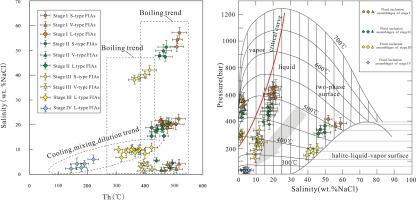Journal of Geochemical Exploration ( IF 3.4 ) Pub Date : 2021-04-18 , DOI: 10.1016/j.gexplo.2021.106796 Qing-fei Sun , Ke-yong Wang , Yi-cun Wang , He Yang , Jian Li , Xue-li Ma

|
The Chaobuleng skarn deposit, located in the Erlian–East Ujimqin region, Northeast China, is a medium-sized Fe Zn polymetallic deposit. Iron-polymetallic mineralization occurs mainly as stratiform, lenticular, and vein types hosted in the contact zone between the Chaobuleng syenogranite and the Devonian Taerbagete Formation. The Chaobuleng deposit is a calcic skarn deposit dominated by a grossular-rhodonite-allanite-epidote assemblage. The ore minerals mainly consist of magnetite, pyrite, sphalerite, chalcopyrite, and bismuthinite, with lesser amounts of molybdenite, arsenopyrite, and pyrrhotine. Four mineralization stages have been identified: (I) a prograde skarn stage; (II) a retrograde skarn stage; (III) a quartz-minor calcite-polymetallic sulfide stage; and (IV) a quartz-calcite-minor pyrite stage. Three types of fluid inclusions (FIs) in garnet, quartz and calcite were classified: vapor-rich two-phase FIs (V-type), liquid-rich two-phase FIs (L-type), and daughter mineral-bearing three-phase FIs (S-type). The homogenization temperatures of FIs from stages I, II, III, and IV are 446–547, 411–519, 279–415, and 147–217 °C, respectively, with corresponding salinities of 0.87–59.47, 0.52–51.52, 0.70–13.25, and 3.05–7.85 wt% NaCl equiv., respectively. The results suggest that mineralization in the Chaobuleng deposit occurred at a depth of 1.0–2.8 km, with fluid boiling and mixing with meteoric water likely being responsible for ore precipitation. The C
Zn polymetallic deposit. Iron-polymetallic mineralization occurs mainly as stratiform, lenticular, and vein types hosted in the contact zone between the Chaobuleng syenogranite and the Devonian Taerbagete Formation. The Chaobuleng deposit is a calcic skarn deposit dominated by a grossular-rhodonite-allanite-epidote assemblage. The ore minerals mainly consist of magnetite, pyrite, sphalerite, chalcopyrite, and bismuthinite, with lesser amounts of molybdenite, arsenopyrite, and pyrrhotine. Four mineralization stages have been identified: (I) a prograde skarn stage; (II) a retrograde skarn stage; (III) a quartz-minor calcite-polymetallic sulfide stage; and (IV) a quartz-calcite-minor pyrite stage. Three types of fluid inclusions (FIs) in garnet, quartz and calcite were classified: vapor-rich two-phase FIs (V-type), liquid-rich two-phase FIs (L-type), and daughter mineral-bearing three-phase FIs (S-type). The homogenization temperatures of FIs from stages I, II, III, and IV are 446–547, 411–519, 279–415, and 147–217 °C, respectively, with corresponding salinities of 0.87–59.47, 0.52–51.52, 0.70–13.25, and 3.05–7.85 wt% NaCl equiv., respectively. The results suggest that mineralization in the Chaobuleng deposit occurred at a depth of 1.0–2.8 km, with fluid boiling and mixing with meteoric water likely being responsible for ore precipitation. The C O isotope data suggest the early ore-forming fluids were mainly related to felsic rocks and were accompanied by intense water/rock reactions during the fluid migration. The S
O isotope data suggest the early ore-forming fluids were mainly related to felsic rocks and were accompanied by intense water/rock reactions during the fluid migration. The S Pb isotopic compositions indicate that ore materials were derived from the mixing between magma and wall rocks. Zircon U
Pb isotopic compositions indicate that ore materials were derived from the mixing between magma and wall rocks. Zircon U Pb dating yields a weighted mean 206Pb/238U age of 135.9 ± 0.8 Ma (MSWD = 1.03), which represents the crystallization time of the syenogranite. Together, these data suggest that the Chaobuleng deposit is a skarn ore system that is spatially, temporally, and genetically related to syenogranite and formed in an extensional environment resulted from the roll back of the subducted Paleo-Pacific Plate.
Pb dating yields a weighted mean 206Pb/238U age of 135.9 ± 0.8 Ma (MSWD = 1.03), which represents the crystallization time of the syenogranite. Together, these data suggest that the Chaobuleng deposit is a skarn ore system that is spatially, temporally, and genetically related to syenogranite and formed in an extensional environment resulted from the roll back of the subducted Paleo-Pacific Plate.









































 京公网安备 11010802027423号
京公网安备 11010802027423号